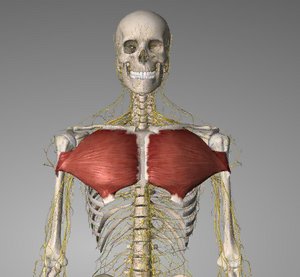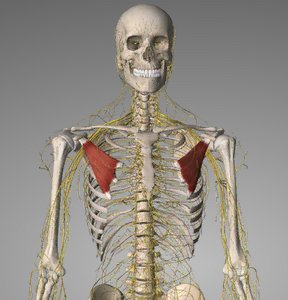Avoid the Rock Climbing Hunchback pt. 2: Mobility
To help or prevent thoracic kyphosis or a climbing hunchback, you’ll need to increase the pliability of the tissues that pull your body into a hunch. The 3 most important areas to address are the pectorialis major, pectorialis minor and the midspine (thoracic spine). You can have a skilled therapist mobilize the tissues or you can use a small round ball (tennis or lacrosse ball) or foam roll against the desired restricted tissue. After the tissues are mobilized, it’s recommended that you perform stretches to maintain the flexibility that you just gained. Below is a series of mobility exercises to combat the restricted tissues.
Soft Tissue Mobilization of Pectoral (Major and Minor)
Pectoralis major tightness will cause the arms to rotate inwards due to the muscle attachment between the thoracic cage and the arm. You can use a tennis ball against the wall and apply pressure on the pec major muscle in the direction of maximal restriction or in a circular fashion to improve mobility in this muscle. You can also use an old carabiner to apply more aggressive pressure. The image below shows the pectorialis major with its origin, insertion and action. Soft tissue mobilization will decrease the likelihood that your arms will rotate inward in a climber’s hunch.
Pectoralis major
Pec minor is another muscle to address in case of climber’s hunch. Tightness of the pectoralis minor can round the shoulder blades forward because of its attachment from the chest wall to the shoulder blade. Using the same method as above (tennis ball or carabiner), the individual can apply pressure on this muscle. However, since this muscle is deeper than the pectoralis major, slightly more pressure is required to reach it.
Pectoralis minor
Pectoralis Minor Soft Tissue Release (3 reps x 30 sec)
Soft tissue mobilization should be followed by stretching to improve the range of motion. After increasing the pliability of pec major and minor, you can stretch the muscles. Hold this position to achieve maximum benefit.
Pectoralis Major Door Frame Stretch (3 reps x 30 sec)
To stretch the pec major muscle, stand between a door frame as shown below with external rotation and horizontal abduction of the arm. Lunge forward to apply force on the muscle.
Pectoralis Minor Foam Roll Stretch
To stretch the pec minor muscle, the climber will position on a foam roller. Since the pectoralis minor attaches to the shoulder blade, a partner can press on the front of the climber’s inner shoulder to isolate only the pec minor. If that is not done, this stretch is for both pectoralis minor and major.
Pectoralis Minor Stretch Progression (3 reps x 30 sec)
To stretch the pectoralis minor, loop a band around your upper arm next to your armpit crease and face away from the anchor. Place your arm behind your head with your elbow bent and move your body forward to feel a stretch in the front part of your shoulder.
Pectoralis Major Stretch Progression (3 reps x 30 sec)
To stretch the pectoralis major, loop a band around your upper arm next to your elbow and face away from the anchor. With your arm bent at 90 degrees, move forward to feel a stretch in front of your shoulder in the pectoral muscle. You can move the band further towards your elbow to increase the stretch or reach your arm up and down in the air.
Thoracic Spine Extension Foam Roll (3 reps x 30 sec)
This exercise targets the thoracic spine directly and pushes the spine in the opposite direction of a climbing hunch. Place the foam roller on the floor and lie on your back with the knees bent while aligning the foam roller horizontally with the shoulder blades. With arms behind the head, lower your head as close as you can to the floor until you feel a stretch behind the back of the thoracic spine. Maintain engaged abdominal muscles and proper low back posture during the exercise and make sure not to overextend your neck.
Thoracic Spine Extension Progression (3 reps x 30 sec)
To progress the thoracic extension, try sitting on a ball and step forward to lower the back onto the ball. Next, place the ball directly under the shoulder blades and open the arms on each side to increase the stretch. Maintain this position and relax.
Try these mobility exercises out and let us know if you feel any pain or discomfort. As always, reach out with questions or to schedule an appointment!
Thank you to Evolution Physical Therapy for sharing this article.


